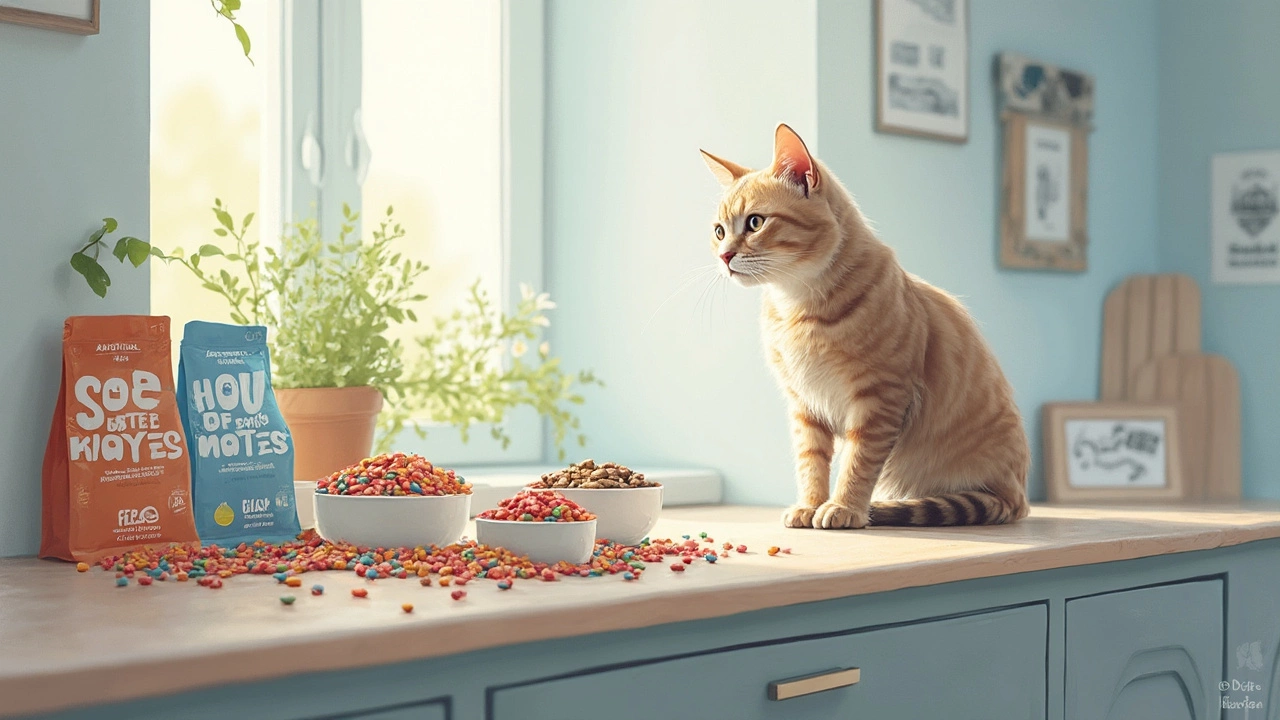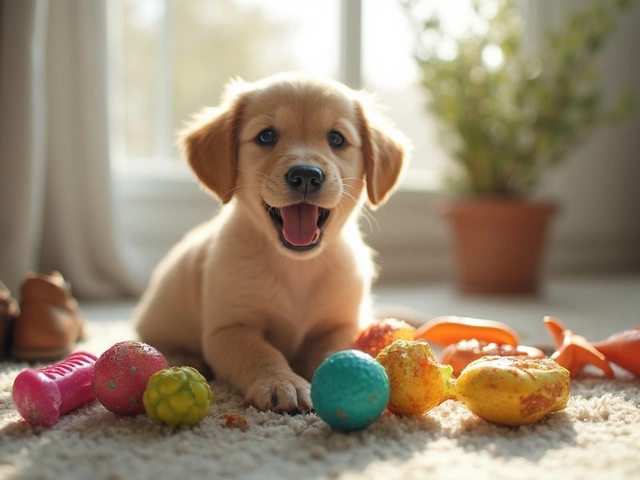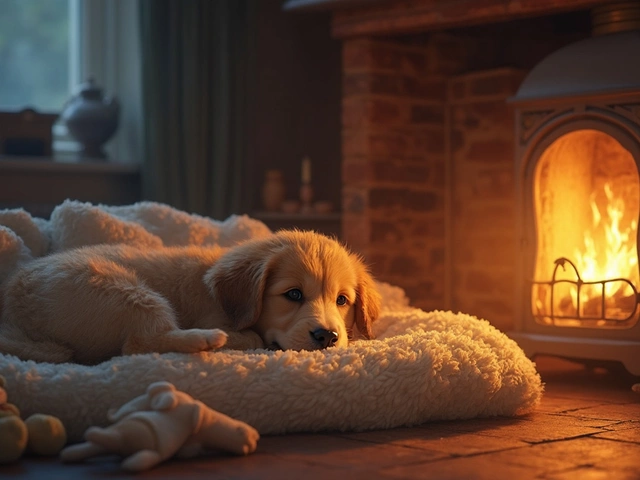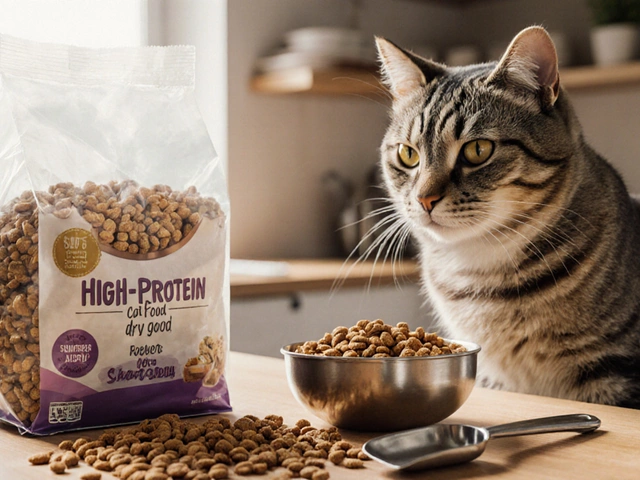Walk down the cat food aisle, and it feels like dry food is everywhere. It’s cheap, easy to store, and picky cats usually gobble it up. But have you ever flipped the bag over and checked what’s actually inside? Those long, tricky ingredient lists aren’t just confusing—they can hide stuff that isn’t doing your cat any favors.
Lots of brands load dry food with ingredients that sound harmless but can end up causing problems for your cat's digestion, weight, or even their kidneys down the road. Some of the worst offenders are common fillers, artificial flavors, and sketchy meat by-products. Even if your cat seems healthy, these ingredients can slowly build up trouble over the months or years.
If you want your cat to be around for a long, happy life, it’s worth learning exactly which ingredients in dry food are best avoided. Let’s break down the sneaky stuff you’ll spot on labels so you can make smarter choices the next time you shop for your furry roommate.
- Surprising Stuff Hiding in Dry Cat Food
- Carbs: Do Cats Really Need Them?
- Artificial Colors and Flavors: Unwanted Extras
- Preservatives: Keeping Food Fresh at a Cost
- Meat By-Products: What Are They, Really?
- Picking a Safer Kibble: Real-Life Tips
Surprising Stuff Hiding in Dry Cat Food
If you look close, dry cat food isn’t just meat and vitamins like the big labels want you to think. It's packed with ingredients that have nothing to do with what a cat naturally needs. Some of these are even linked to health issues, especially if your cat eats the same thing day in and day out.
Dry cat food is famous for using plant-based fillers. Things like corn, wheat, and soy show up all the time. Why? They’re cheap, keep kibble crunchy, and boost profit for big companies. But cats don’t need these carbs—they’re obligate carnivores, which means their bodies run best on animal protein, not grains.
- Corn Gluten Meal: Used to boost protein numbers on the label but doesn't give cats the amino acids they actually need.
- Wheat Middlings: Basically the leftovers from processing wheat. There’s not much nutrition for cats, but they're cheap to add in.
- Soybean Meal: Plant protein, not useful for feline health and can cause gas or tummy upset in sensitive cats.
It doesn't stop at fillers. Many dry foods include artificial colors and flavors to make the kibble look and taste “better” to humans—cats don’t care what color their food is, but those dyes can spark allergic reactions.
"Cats have no dietary requirement for carbohydrates. Yet, many dry foods can contain up to 50% carbs from grains and starches."
— Pet Nutrition Expert, Dr. Lisa Pierson, DVM
Besides, some recipes rely on salt and sugar to hook your cat on their flavor. Yup, just like junk food for people. While a little sodium is necessary for cats, too much can be risky. And sugar? Cats can’t even taste it and don’t need it at all.
| Common Filler | Why It's Used | Possible Risk |
|---|---|---|
| Corn Gluten Meal | Pumps up protein numbers | Poor amino acid profile |
| Wheat | Bulks out food, low cost | Can cause allergies |
| Soy | Cheap source of protein | May upset digestion |
If you spot a big cluster of plant-based stuff at the top of an ingredient list, that’s a clue the food is packed with fillers. For the healthiest cat food, try to pick something where named animal proteins (like chicken or turkey meal) show up first. Your cat’s body will thank you for it with better health in the long run.
Carbs: Do Cats Really Need Them?
Most people don’t realize it, but cats aren’t wired to munch on carbs. In the wild, a cat’s menu is about 2% carbohydrates—think tiny amounts from stuff inside their prey’s belly. Modern dry cat food can flip that number on its head, packing in 30–50% carbs just to create those little crunchy nuggets. That’s a huge change.
Cats are what vets call obligate carnivores, meaning they’re built to run on protein and fat. Their bodies can’t process carbs very well. When you overload their diet with corn, rice, wheat, or potatoes—all common kibble fillers—they end up storing the extra sugar as body fat. That’s why indoor cats eating mostly dry cat food have higher chances of getting chubby or even developing diabetes.
“Cats have a limited ability to digest carbohydrates, and diets high in carbs can lead to obesity and insulin resistance,” says Dr. Lisa Pierson, a respected feline nutrition expert.
Check out real ingredient labels. If you see grains or starches listed first or second, you’re probably paying for a bag of carbs with just a sprinkle of meat for taste. And cats aren’t getting what they really need. Here’s a quick side-by-side of what’s wild vs. what’s in the typical grocery store kibble:
| Wild Cat Diet | Commercial Dry Cat Food | |
|---|---|---|
| Carbs (%) | 2-5 | Up to 50 |
| Protein (%) | 50-60 | 25-40 |
| Main Ingredient | Meat | Grains/Starch |
Want to do better for your cat? Look for kibble with meat or fish as the first ingredient, and skip bags loaded with corn, soy, or potatoes. If you can, add some wet food to the mix to bump up protein and bring those carb levels down—your cat’s waistline and energy will thank you.
Artificial Colors and Flavors: Unwanted Extras
This part of dry cat food is where things get a bit sneaky. Cat food brands add these extras—artificial colors and flavors—not for your cat, but for you. Bright colors make kibble look “meaty” or “fresh,” but cats literally see colors differently than we do. The truth is, they don’t care if their food is brown or neon orange.
The worry with artificial flavors and colors is twofold. First, some dyes used in pet food (like Red 40 or Yellow 5) have been linked to allergies and stomach issues in animals, even though they're technically legal. The FDA has approved many of them for short-term use, but no one really knows the effect of a lifetime eating these chemicals. Dr. Jennifer Coates, DVM, puts it bluntly:
"Cats don't benefit nutritionally from artificial colors or flavors, and there is a potential for adverse reactions, especially in sensitive pets."
Same thing with artificial flavors—they cover up the taste of lower-quality ingredients so cats eat up food they might not touch otherwise. Sometimes the labels even say ‘animal digest’ or ‘flavoring,’ and it's hard to know what those really mean.
Here’s how you can spot unwanted extras in your cat food:
- Check the ingredients for anything with a color name and number (like "Blue 2" or "Yellow 6").
- Beware words like “flavor,” “artificial flavor,” or “animal digest”—these usually mean stuff added just to trick your cat’s taste buds.
- If a food looks bright or oddly colored, it almost always has dyes.
If a company puts more effort into making food look appealing to humans than focusing on cat health, it’s a red flag. Choose kibble that lists real meat, not flavorings or dyes, at the top. Your cat’s body will thank you—even if their food looks boring to you.
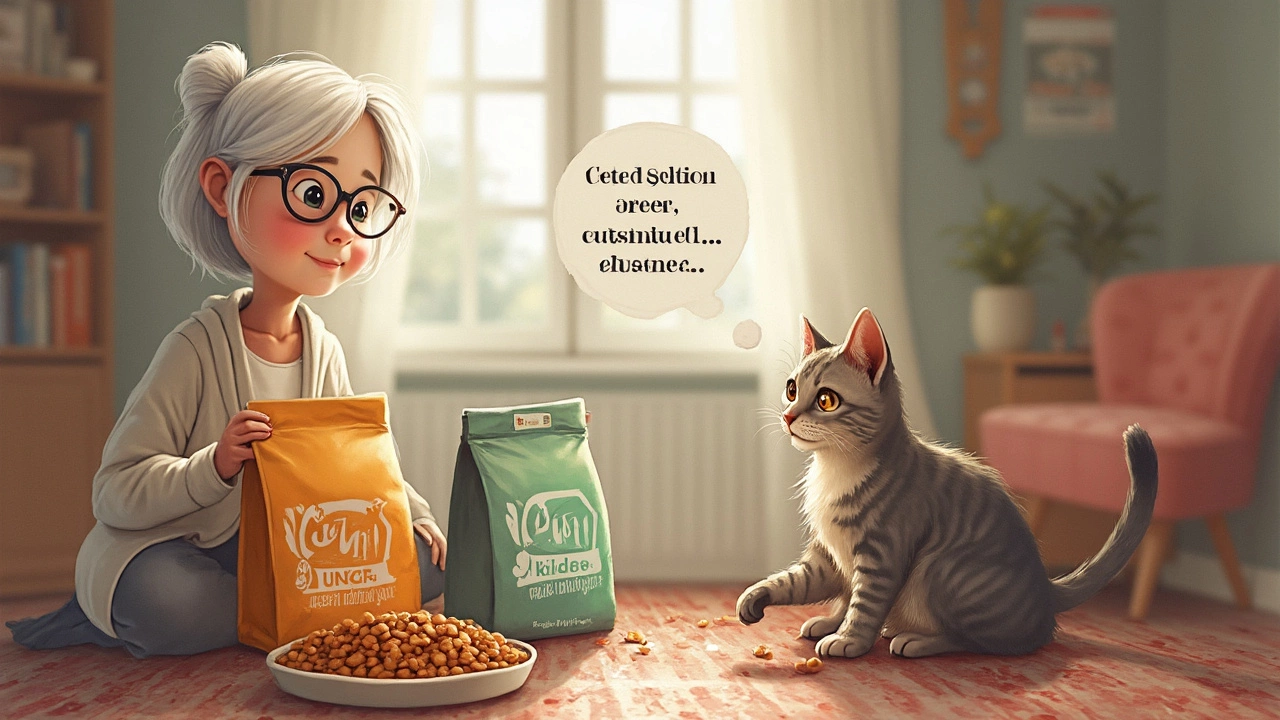
Preservatives: Keeping Food Fresh at a Cost
Preservatives might sound like a smart way to keep dry cat food safe from spoilage, but not all of them are good news for your cat. Sure, they stop food from going rancid and let that bag of kibble sit for months without changing, but some common additives have sketchy track records when it comes to cat health.
The biggest troublemakers are BHA (butylated hydroxyanisole), BHT (butylated hydroxytoluene), and ethoxyquin. These are synthetic chemicals made to stop fats in the food from spoiling. They show up in a lot of cheaper dry cat food brands. The thing is, there’s real debate over whether these preservatives carry risks for pets who eat them day after day. Research in animals like mice and rats has linked BHA and BHT to cancers and organ problems when eaten long-term, even though those tests used bigger amounts than most cats would get from food. Still, it’s enough to make a lot of vets and nutritionists nervous.
Ethoxyquin isn’t as common as it used to be, but it pops up sometimes—especially in foods featuring fish meal. This chemical was even banned from use in human food back in the 1990s, but pet food rules are not as strict. High doses have been tied to liver and kidney issues in animals, and while most foods stick to lower concentrations, the risk is still on the radar for cat lovers who want to play it safe.
If you want to dodge these controversial ingredients, here’s what to look for on labels:
- Avoid anything listing BHA, BHT, or ethoxyquin, especially near the top of the ingredient list.
- Look for natural preservatives like mixed tocopherols (vitamin E), rosemary extract, or vitamin C (sometimes labeled as ascorbic acid). These are much gentler and get the job done without the baggage.
- Choose brands that advertise “no artificial preservatives” or who list every preservative plainly, not tucked under vague phrases like “added to preserve freshness.”
Ready for a quick peek at what might be lurking in that kibble bag? Here’s a handy table showing some common preservatives and their typical risks:
| Preservative | Where It’s Found | Possible Risk |
|---|---|---|
| BHA | Cheap dry kibble, treats | Cancer concerns, organ issues in high doses |
| BHT | Budget dry cat foods, some treats | Linked to tumors, long-term health worries |
| Ethoxyquin | Fish meals, imported foods | Liver and kidney effects at high levels |
| Mixed Tocopherols | Quality/natural brands | Safe, no known issues |
The best bet? Stick with cat food brands that are upfront about what goes in the bag and use natural options to keep things fresh. It might cost a bit more, but you’ll sleep easier knowing your cat’s food isn’t full of stuff you’d never eat yourself.
Meat By-Products: What Are They, Really?
If you ever squint at the label on dry cat food and see "meat by-products," you’re not alone. It sounds like it might just be regular meat, but it’s a lot less simple than that. In fact, meat by-products are the leftovers from animal carcasses after the main cuts, like muscle meat, have been removed for human food. Think organs (not always the nutritious ones), fatty tissue, and sometimes even beaks or lungs. None of this sounds appetizing—and trust me, your cat can do better.
The real catch? By-products aren’t always high-quality. There are some good organ meats in there, like liver or heart, but there could just as easily be stuff with little nutritional value. And since the law doesn’t demand brands specify exactly what’s in their meat by-products, you’re mostly guessing each time you pour out a bowl of kibble. That’s not great for pet owners who want control over what they’re feeding their furry buddies.
Here’s a quick comparison between real meat and meat by-products so you can see what your cat food might be serving up:
| Ingredient | What It Is | Nutritional Value |
|---|---|---|
| Chicken (or other meat) | Real, named muscle meat | High in protein, good amino acids |
| Meat By-Product | Organs, fat, sometimes low-value bits | Can be hit or miss (sometimes good, often poor) |
Not all by-products are bad, and sometimes cats do need those special organ nutrients. But the problem is, most dry cat food that relies on by-products isn’t very transparent about quality. The best thing you can do? Look for foods that name their meat sources (like "chicken" or "turkey") first, instead of vague "meat by-products." The closer you can get to real, whole protein, the better shot your cat has at a healthy life.
If you want more control, avoid brands that treat the ingredient list like a dumping ground for leftovers and mystery parts. Your cat’s health is worth the extra two minutes reading the label.
Picking a Safer Kibble: Real-Life Tips
When it comes to shopping for dry cat food, the label is your best friend (or enemy—depending on what’s in there). Most big brands fill their bags with long ingredient lists, but you can spot better choices if you know what matters. Not all kibble is terrible, but choosing the right one makes a big difference for your cat’s health.
Here are simple ways to find safer, healthier food for your cat:
- Check protein sources first. The first ingredient should be named meat like chicken, turkey, or salmon—not "meat by-products" or "meat meal." If grains or corn are listed first, put that bag back.
- Avoid artificial stuff. Look out for colors (Red 40, Blue 2), fake flavors, and sweeteners. Cats don’t care if their food is bright orange, and these extras just add junk.
- Skip hard-to-pronounce preservatives. Ingredients like BHA, BHT, and ethoxyquin aren’t needed. Instead, look for natural preservatives like mixed tocopherols (basically vitamin E).
- Focus on low carbs. Cats are carnivores, not bread fans. Pick foods with less than 30% carbs if you can. Studies have shown that cats don’t need much carbohydrate—too much raises their diabetes risk.
- Ditch the cheap fillers. If you see lots of corn, wheat, or soybean, it means the brand is cutting corners. Fillers give zero benefit and might mess with your cat’s digestion.
- Be honest about price vs. quality. Super basic kibble is cheap for a reason—it’s packed with fillers. Spending a little more upfront can mean fewer vet bills later.
Ever wondered how much protein, fat, or carbs your cat’s food really has? Here’s an example comparison from 2024 data:
| Brand | Protein (%) | Fat (%) | Carbs (%) |
|---|---|---|---|
| High-end Premium Kibble | 38 | 18 | 16 |
| Mid-range Brand | 32 | 14 | 32 |
| Grocery Store Cheap Kibble | 26 | 9 | 48 |
Always look for clear numbers on the label, and don’t be afraid to email brands if you can’t find what you need. If your cat’s coat is shiny, their energy is good, and you’re not fighting litter box disasters, you’re probably on the right track. Small tweaks in their diet can make a lifetime of difference—so every label check counts.
